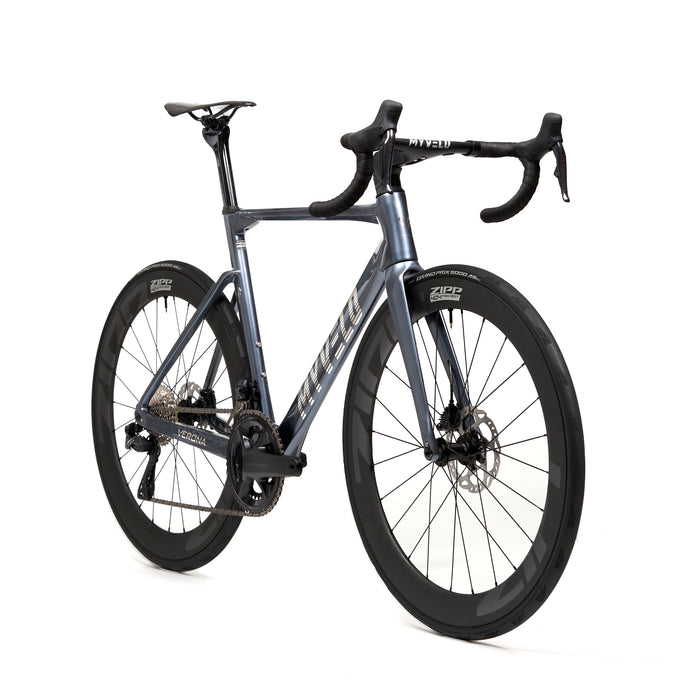
Verona road bike
incl. FREE shipping & free returns

Von Lukas Vogt |
4 minutes read time

In this article I will show you what aerobic training means exactly, why it is so important and how you can optimally integrate it into your road bike training.
Aerobic training is a form of training in which your body primarily uses fat and carbohydrates to generate energy. These processes take place with a sufficient supply of oxygen - hence the term "aerobic", which means "with oxygen". You train at a moderate intensity level in which you can still carry on a conversation without having to gasp for air. This range is usually around 60-75% of your maximum heart rate .
In contrast, there is anaerobic training , where your body burns mainly carbohydrates without oxygen during intense exercise phases. This type of training leads to exhaustion more quickly and primarily serves to improve your peak performance. But the basis on which this performance is built is aerobic training.
Aerobic exercise is the foundation for any form of athletic performance, especially in endurance sports such as road cycling. Here are some of the key benefits:
Improved fat burning : Your body learns to use fat more efficiently for energy. This is especially helpful on long rides, as you can conserve your carbohydrate stores.
Increased capillarization : During aerobic training, your body forms new capillaries (smallest blood vessels), which improves the oxygen supply to the muscles. The result is increased endurance performance.
Increase in heart volume : Regular aerobic exercise enlarges your heart, allowing it to pump more blood per beat. This lowers your resting heart rate and makes your heart work more efficiently.
Increasing mitochondria : Mitochondria are the "powerhouses" of your cells. More mitochondria mean more energy production, which further improves your endurance.
More stable recovery phases : Those who have a strong aerobic base regenerate faster. After intensive sessions or races, your body recovers more efficiently because it can deliver more oxygen and nutrients to the stressed muscles during the recovery phases.
Aerobic training is not complicated, but it does require patience and a structured plan. Here are a few tips on how to best approach it:
Determine your heart rate zones : Before you start aerobic training, you should know your individual heart rate zones. You can either have them determined in a performance test (e.g. a performance diagnostic) or use a rule of thumb. A rough estimate for the maximum heart rate is: 220 minus your age. Your aerobic training zone is then between 60-75% of this maximum heart rate.
Ride long and easy : To improve your aerobic fitness, you should take long, easy rides. The rule here is: length is more important than speed. Set yourself the goal of riding for at least 1.5 to 3 hours at a time at a moderate pace. This may seem boring at first, but it is essential to increase your endurance in the long term.
Frequency and regularity : Aerobic training only shows its full effect after a while. Two to four aerobic sessions per week are ideal, depending on your level of training and goals. Regularity is important - you will only achieve long-term progress if you keep at it.
Train in the right intensity range : It is often tempting to go faster. But that is exactly where the mistake lies: really stay in the aerobic range. A common beginner's mistake is to go too fast and slip into the anaerobic range without noticing. Therefore, use a heart rate monitor or power meter to monitor your training range.
In addition to the right training intensity, your diet also plays an important role in making aerobic training effective. It is particularly important to ensure you have enough carbohydrates and fats. During long aerobic sessions, your body empties its glycogen stores after a while and begins to use more fat as an energy source. It is therefore advisable to eat a carbohydrate-rich meal before long rides and to ensure you have enough energy during the ride (e.g. in the form of bars or gels).
Equally important is proper nutrition after training. Your body needs a combination of proteins and carbohydrates after training to repair muscles and replenish glycogen stores. A recovery drink or meal within the first 30 minutes after training is therefore ideal.
Aerobic training alone is not enough to reach your full potential as a road cyclist. You need to combine it with more intense sessions that improve your anaerobic threshold and your VO2max (maximum oxygen uptake). Here is a rough overview of what a balanced training plan might look like:
Although the concept of aerobic training is relatively simple, there are a few common mistakes you should avoid:
Too high an intensity : As mentioned above, it is important not to go too fast. Many cyclists tend to do their aerobic rides at too high a pace and slip into the anaerobic zone, thus defeating the purpose of the workout.
Long rides too infrequently : Another mistake is not doing long sessions regularly enough. It is on longer rides that you will benefit the most from burning fat and improving your endurance.
Underestimating recovery : After a hard week with multiple sessions, it's tempting to keep pushing. But your body needs recovery to get stronger. So make sure you take enough breaks and easy days.
Aerobic training is the foundation of any successful road bike season. It may seem less exciting than intense intervals, but it is essential for increasing your endurance in the long term. By regularly incorporating long, easy rides into your training plan and paying attention to the right intensity, you will not only become faster, but also more efficient and more enduring on the road bike. Stay patient, stick to your plan, and the results will not be long in coming!

Als Rennradfahrer möchte man möglichst ständig besser werden: schneller, ausdauernder und effizienter. Doch was, wenn der Schlüssel zu diesen Zielen nicht nur auf zwei Rädern liegt? Rudern, oft unterschätzt, bietet eine ideale Ergänzung zum Radtraining. Es trainiert nicht nur den ganzen Körper, sondern verbessert auch die Ausdauer, Kraft und Stabilität – entscheidende Faktoren für jeden Radsportler.

Nach einer intensiven Rennrad-Einheit ist die richtige Regeneration entscheidend, um Leistung zu verbessern, Verletzungen zu vermeiden und langfristig Fortschritte zu erzielen. Doch wie sieht eine effektive Erholung aus? Hier bekommst Du die besten Tipps zur optimalen Regeneration nach dem Rennradtraining.

Erfahre, wie Radsport-Ligen aufgebaut sind und weitere Infos zur Organisation im Profi-Radsport!